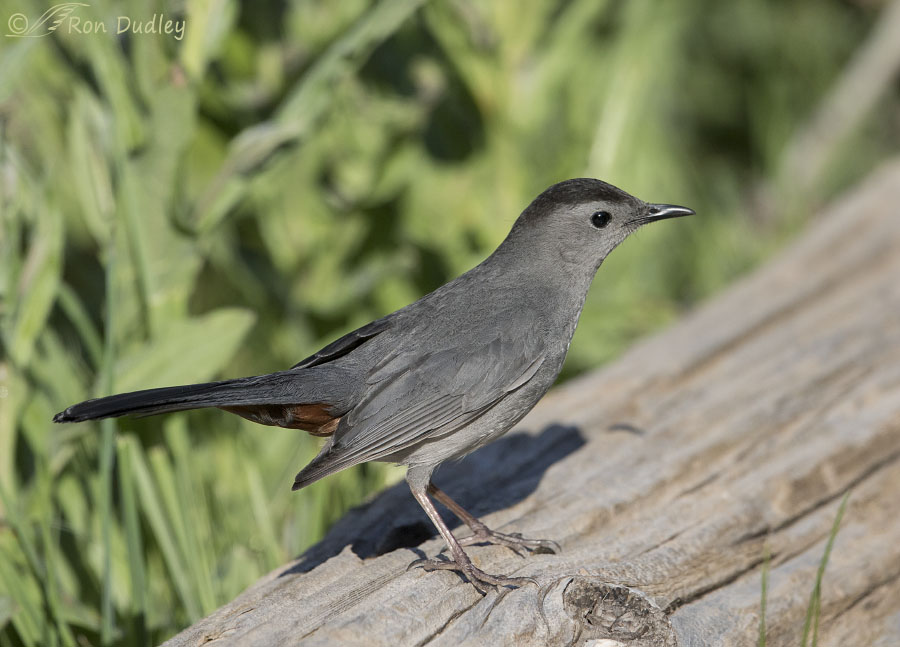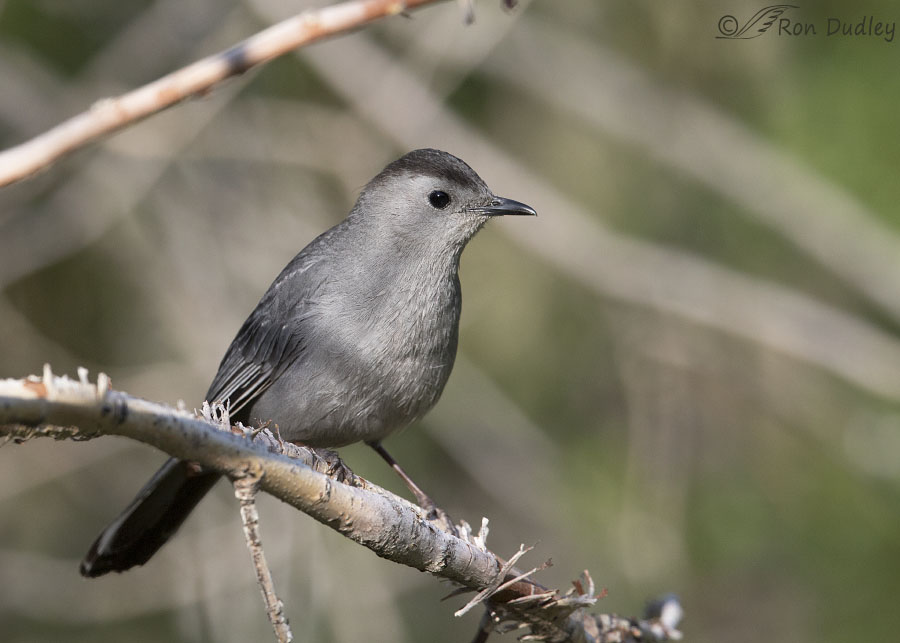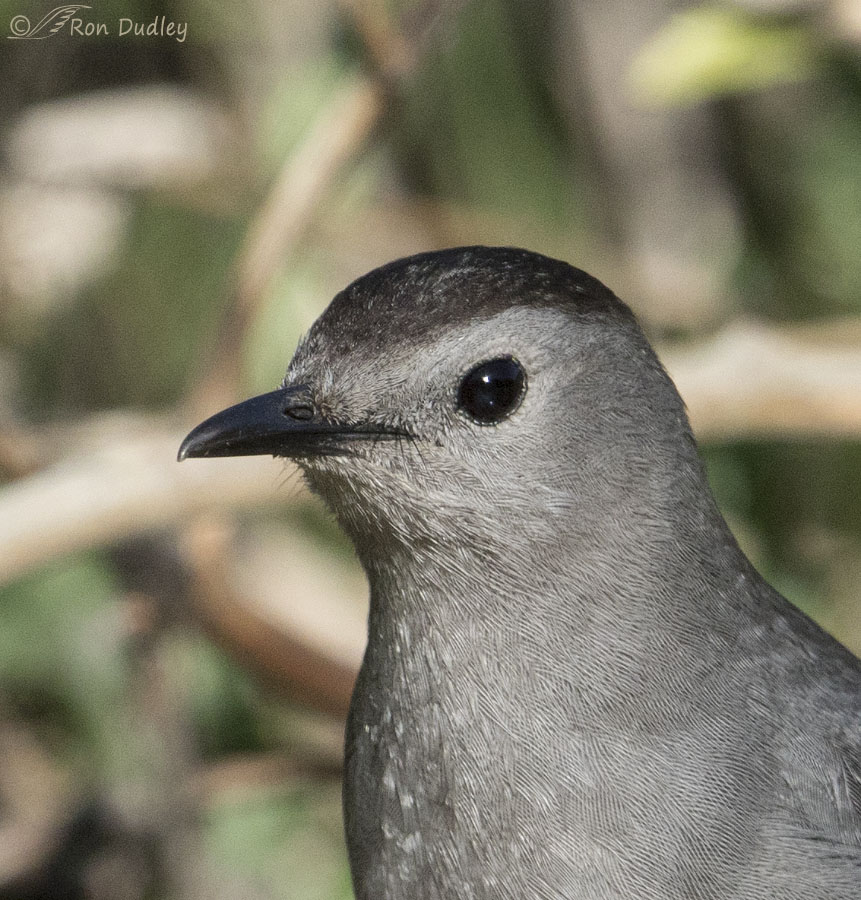We still don’t know the function of rictal bristles but there’s been lots of conjecture over the years.
Gray Catbirds are so abundant in some areas of the U.S. that many birders ignore them but here in Utah we’re right on the edge of their range and the few I do see (or more often only hear) are elusive subjects for me. So yesterday morning in the Wasatch Mountains when this one came in close there was absolutely no chance I was going to ignore it.

1/3200, f/6.3, ISO 800, Canon 7D Mark II, Canon EF 500mm f/4L IS II USM + EF 1.4 III Extender, not baited, set up or called in
As per usual with this species we heard it before we saw it so I pulled my pickup off the road and waited to see what might happen. Uncharacteristic of catbirds this one flew out of the bushes and landed on a log right next to me – so close that this image has been cropped very little (it’s 90% of full frame). Its behavior made us wonder if it might have a nest in the immediate vicinity.

1/2000, f/6.3, ISO 800, Canon 7D Mark II, Canon EF 500mm f/4L IS II USM + EF 1.4 III Extender, not baited, set up or called in
It landed on several other nearby perches but all of them were a little (or a lot) messy.
If you look closely at both of the previous photos you’ll notice that this bird has black “whiskers” at the base of the bill. These very stiff, hair-like feathers called rictal bristles are found on only a few groups of birds, including flycatchers.

1/2500, f/6.3, ISO 800, Canon 7D Mark II, Canon EF 500mm f/4L IS II USM + EF 1.4 III Extender, not baited, set up or called in
A very large crop (1.5% of the original image) of another photo of the same catbird gives us a better look at the bristles.
There’s been speculation for years that the function of rictal bristles is either sensory (to help them sense or capture prey) or that they might aid in preventing captured insects from scratching the bird’s eyes while they’re being held in the bill. But those potential functions are only educated guesses and there’s apparently no specific evidence to support either one. So in reality the exact purpose of rictal bristles is still unknown.
Catbirds are named for their mewing cat-like call but what could be more fitting than for them to also have “whiskers” similar to those on our furry, feline friends…
Ron


Thanks Teacher. I am so glad that you haven’t given up your previous profession. And equally glad to not that ‘I don’t know’ is not an admission of shame here.
EC, one of the first lessons I learned as a young teacher was to admit I didn’t know something rather than try to fake it. It was a lesson learned painfully but I learned it well…
How I wish rather a lot more people would take that lesson on board. Publically.
Along with the pleasure your photos bring, I learn something new from almost every post. I wonder if the bristles are more about preventing escape than capture, but I’m coming from a place of ignorance about the mechanics of flycatching.
Catbirds here in the east are often quite willing to interact with humans. They have the curiosity of their mockingbird cousins with much less aggression. I can remember “mewing” to catbirds in the neighbor’s grape vines; they’d pop out from a different place each time, mew back, and disappear again.
That experience with the catbirds must have been fun, Robyn!
It was definitely one of the experiences that kindled a life-long fascination with birds!
I think rictal bristles might also be called vibrissae? Which is what cat whiskers technically are (along with many other species), although I’m sure that comparison has nothing to do with the name of this bird. Thanks for the informative post and, as usual, the stunning pictures.
Thanks, Lyle.
I think they’re usually called rictal bristles on birds because they’re made of feathers instead of hair.
I love this bird with its whiskers and black strip on the head. Sure wish I could hear it sometime. It would be a real treat.
Glad you were able to capture it for our viewing.
Thanks, Ron
Alice, they often make other calls besides the “cat sounds”. I’ve only heard that call a few times. Thanks.
Thank you for my education moment of the day! I had not learned of rictal bristles before now, and the photographs show them perfectly. Perhaps the bristles are there to give us a sense of wonderment.
Thanks very much, Miriam.
These are great shots, beautiful job!
We humans want an answer for anything and everything. Sometimes we don’t know the answer. The only thing I can offer relative to rictal bristles is that they could have evolved from their ancestor having a function at one time or one of those instances when the evolution experiment was physical without an application. That sometimes happens throughout biological history. My 2 cents.
Thanks, Dick. Yes, there’s all kinds of possibilities…
They are actually pretty to me in their uniform grey.
I agree.
I was blown away by the level of resolution in that last shot you posted which clearly showed the neck and breast feathers criss-crossing each other at an ( almost ) right angle…..
what wonderful insulation as well as protection they must provide ! Is the catbird’s plumage especially pronounced in this feature, or have you captured it in other species ?
Kris, some birds have “finer” feathers than others so detail on them is more difficult to get but it isn’t unusual for me to capture this much detail when I’m close to the bird. A high quality lens makes all the difference!
When People saw our barn, they used to drop off poor, unwanted animals in a tangle of grapevines near the road…often kittens. My sisters and I went crazy looking for “the kitten” one time…it turned put to be a very convincing catbird. They can make a slew of sounds and were quite “tame” and curious….much like our chickadees..
Just goes to show where the name “catbird” came from!
Ron, Thanks for the enlarged photo allowing me to see the bristles. And you got a catch light as well. Diana
I’m glad you found it useful, Diana.
Beautiful photos, Ron! I usually have a pair of Catbirds nesting in my yard each year, so I wasn’t surprised this spring when I saw one eating one of the oranges I had put out for the Orioles. But the next day I had four Catbirds, and the day after that I had six! All six stayed for about a week – pure Catbird joy in my book!
It must have been fun to have that many catbirds around, Diane. I didn’t know they ate fruits so I looked it up and they’re known for it.
I’ve only heard a Catbird sounding like a cat one time, a very memorable experience. When I’m in Catbird range, I always enjoy watching them because they seem to have great personalities. I have not previously been aware of the rictal bristles – but I think I’ve not been close enough to a member of the species to even hope to see them. I like the idea that they have whiskers like their namesake.
“I’ve only heard a Catbird sounding like a cat one time”
I’ve heard it a fair number of times, Susan. They also incorporate mimicry into their songs and on this same morning I heard one very clearly mimicking a robin (there are many robins in this mountainous area).
Lucky you! He came to you! These are great photos.
Elusive, mewing and hiding in the bushes…yup it’s a catbird. Sometimes you can wait and wait thinking he’ll pop out but nada. I love the flash of that rufous rump when he does grace you with his presence.
Thanks, Kathy. This one gave me very few looks at the rufuous rump but it was unusually cooperative in other ways.
The first photo REALLY captures the bird…….:) Definitely have cat like whiskers! Whatever the reason they are subtly beautiful birds.
“they are subtly beautiful birds”
I think so too, Judy. I like their black cap and the rufous under the base of the tail.
Wonderful series Ron!
Charlotte
Thanks, Charlotte.